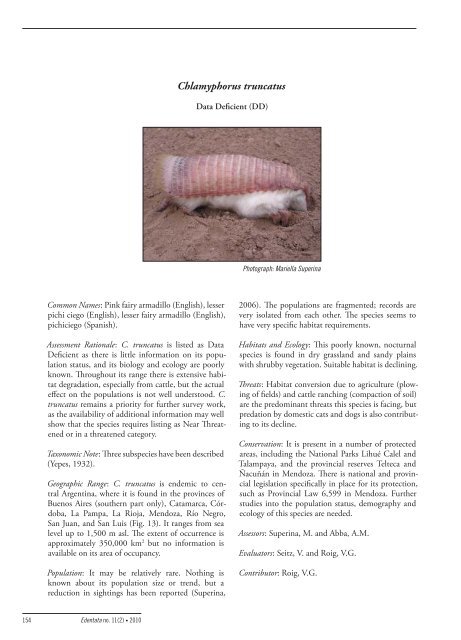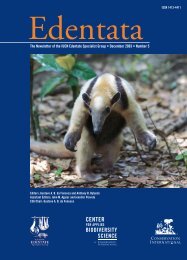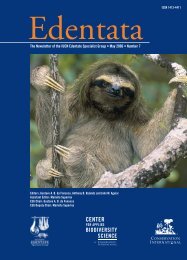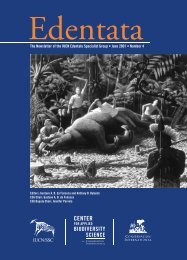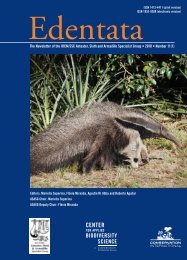Edentata 11(2), 2010 - Anteater, Sloth & Armadillo Specialist Group
Edentata 11(2), 2010 - Anteater, Sloth & Armadillo Specialist Group
Edentata 11(2), 2010 - Anteater, Sloth & Armadillo Specialist Group
- No tags were found...
You also want an ePaper? Increase the reach of your titles
YUMPU automatically turns print PDFs into web optimized ePapers that Google loves.
Chlamyphorus truncatusData Deficient (DD)Photograph: Mariella SuperinaCommon Names: Pink fairy armadillo (English), lesserpichi ciego (English), lesser fairy armadillo (English),pichiciego (Spanish).Assessment Rationale: C. truncatus is listed as DataDeficient as there is little information on its populationstatus, and its biology and ecology are poorlyknown. Throughout its range there is extensive habitatdegradation, especially from cattle, but the actualeffect on the populations is not well understood. C.truncatus remains a priority for further survey work,as the availability of additional information may wellshow that the species requires listing as Near Threatenedor in a threatened category.Taxonomic Note: Three subspecies have been described(Yepes, 1932).Geographic Range: C. truncatus is endemic to centralArgentina, where it is found in the provinces ofBuenos Aires (southern part only), Catamarca, Córdoba,La Pampa, La Rioja, Mendoza, Río Negro,San Juan, and San Luis (Fig. 13). It ranges from sealevel up to 1,500 m asl. The extent of occurrence isapproximately 350,000 km 2 but no information isavailable on its area of occupancy.Population: It may be relatively rare. Nothing isknown about its population size or trend, but areduction in sightings has been reported (Superina,2006). The populations are fragmented; records arevery isolated from each other. The species seems tohave very specific habitat requirements.Habitats and Ecology: This poorly known, nocturnalspecies is found in dry grassland and sandy plainswith shrubby vegetation. Suitable habitat is declining.Threats: Habitat conversion due to agriculture (plowingof fields) and cattle ranching (compaction of soil)are the predominant threats this species is facing, butpredation by domestic cats and dogs is also contributingto its decline.Conservation: It is present in a number of protectedareas, including the National Parks Lihué Calel andTalampaya, and the provincial reserves Telteca andÑacuñán in Mendoza. There is national and provinciallegislation specifically in place for its protection,such as Provincial Law 6,599 in Mendoza. Furtherstudies into the population status, demography andecology of this species are needed.Assessors: Superina, M. and Abba, A.M.Evaluators: Seitz, V. and Roig, V.G.Contributor: Roig, V.G.154<strong>Edentata</strong> no. <strong>11</strong>(2) • <strong>2010</strong>


